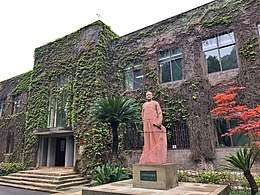Chang Po-ling
Chang Po-ling (Chinese: 張伯苓; pinyin: Zhang Boling; April 5, 1876 – February 23, 1951) was a Chinese educator who, with Yan Xiu, founded Nankai University and the Nankai system of schools.
Chang Po-ling 張伯苓 | |
|---|---|
 | |
| Born | April 5, 1876 Tianjin, Qing Dynasty |
| Died | February 23, 1951 (aged 74) Tianjin, People's Republic of China |
| Nationality | Republic of China |
| Alma mater | Saint John's University, Shanghai |
| Political party | Kuomintang |
| Chang Po-ling | |||||||||
|---|---|---|---|---|---|---|---|---|---|
| Traditional Chinese | 張伯苓 | ||||||||
| Simplified Chinese | 张伯苓 | ||||||||
| |||||||||
Biography

Chang Po-ling was born in Tianjin in 1876 during the last years of the Qing Dynasty. His younger brother was P.C. Chang, a philosopher and diplomat. He graduated from the Beiyang Naval Academy in 1894.[1] He was a cadet officer in the Beiyang Fleet, but he abandoned his training after the fleet was destroyed during the First Sino-Japanese War. He attended and graduated from Saint John's University in Shanghai.
After several years of teaching, Chang Po-ling organized funding for a private college preparatory school, Nankai High School, in Tianjin in 1904. In 1917 he briefly studied at Teachers College, Columbia University in the United States, where he was influenced by the American educator and reformer John Dewey. Afterwards, he expanded his school into a full university, Nankai University, in 1919. Under Chang's leadership, Nankai continued to expand for the next few years and became one of the most prestigious universities in China.
He was noted for his emphasis on athletics, which he believed would rid China of its image as the 'Sick man of Asia' in the early 1900s, quoting that 'only a good sportsman can be a good teacher'. He established a number of annual national athletic meets and the forerunner to the modern Chinese Olympic Committee. He established several smaller institutions, including a girls middle school (1923), experimental primary school (1928), institute of economics (1927), and of chemistry (1932).
During the 1930s, Chang Po-ling anticipated the possibility of war with Japan and made preparations to evacuate Nankai University and Nankai High School from Tianjin to the Chinese interior. As part of these preparations, he founded the Chongqing Nankai Middle School in 1936. When the Second Sino-Japanese War began on July 7, 1937, Chang Po-ling evacuated the entire Nankai system of schools to Changsha, Hunan province.
As the Japanese military advanced towards the Chinese interior, Chang Po-ling organized a second evacuation to Kunming, Yunnan province in 1938. In Kunming, Nankai University joined with Peking University and Tsinghua University to form the National Southwestern Associated University, which continued to educate the top students in China until the war ended in 1945. Afterwards, Nankai University returned to Tianjin.
Chang Po-ling died in Tianjin in 1951.
References
- Lee Hamrin, Carol; Bieler, Stacey (2010). Salt and Light, Volume 2: More Lives of Faith That Shaped Modern China. Eugene, Oregon: Wipf and Stock. p. 184. ISBN 978-1606089552.
- Fairbank, John King. The Great Chinese Revolution: 1800-1985. New York: Harper & Row, 1986.